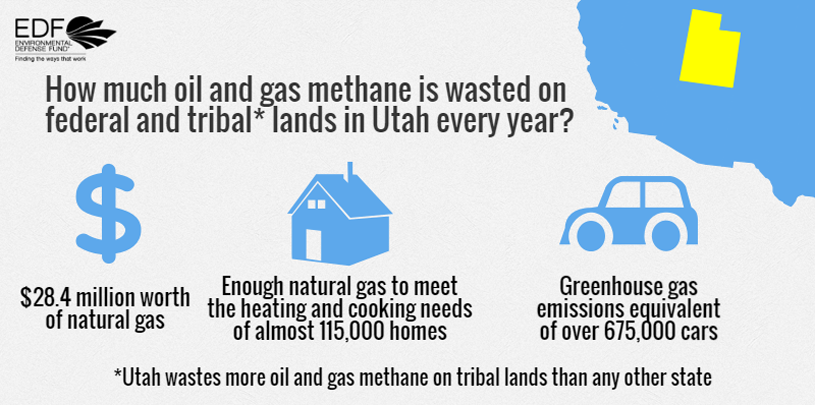
 by Anne Mariah Tapp, Energy Director
by Anne Mariah Tapp, Energy Director
A new report reveals that the extent of methane emissions from energy development on tribal and public lands in Utah is greater than we ever realized. But this report also lays the foundation for a triple win that could result from better methane capture regulations for the oil and gas industry, including cleaner air for Utah’s Uintah Basin, more federal and tribal royalties flowing to schools, roads, and improvements, and climate solutions that would benefit Utah, the Colorado Plateau, and the nation.
In late June, ICF International, a consulting firm specializing in energy issues, released an analysis of methane emissions from oil and gas development on federal and tribal lands across the United States. The report shows that in 2013, nearly 48 billion cubic feet of natural gas was lost through leaks and venting on federal lands in the U.S. On tribal lands, nearly 18 billion cubic feet of natural gas was wasted.
In Utah alone, ICF International calculated that $28.4 million dollars worth of natural gas escapes into the atmosphere every year from federal and tribal lands, a quantity that could meet the heating and cooking needs of 115,000 homes and equals the greenhouse gas equivalent of 675,000 cars on the road. Utah ranks worst in the nation for methane wasted on tribal lands, losing more than $17 million worth of natural gas from tribal lands in the state each year.
A key problem contributing to this waste is that the Bureau of Land Management imposes almost no federal limits on the amount of natural gas that oil and gas operations can emit. This helps make the oil and gas sector the nation’s largest industrial source of methane pollution, as well as a key source of other air pollutants that have toxic effects and contribute to smog.
The extent of the problem revealed by this report, while not good news, poises us for a triple win as the BLM prepares to issue new rules regulating methane emissions from the oil and gas industry.
When companies fix methane leaks, they also cut other types of air pollution, including ozone-forming pollutants and toxic hitchhiker chemicals such as benzene. This will help combat air quality problems in Utah’s Uintah Basin, where ground-level ozone reaches crisis levels during the winter months.
Wasted methane equals wasted profits. Every cubic foot of methane that hisses out of a pipe or is flared into the atmosphere could be captured and sold at a profit. And the taxpayer ultimately loses. ICF International’s report reveals that, in 2013, the government forfeited over $31 million that it could have collected in royalties from lost natural gas. Instead of disappearing into the air, these royalties should be flowing to tribal nations, counties, schools, roads, and hospitals.
Natural gas holds promise for addressing global warming because using it to generate electricity releases lower quantities of greenhouse gases than using coal. That benefit, however, is undermined when so much methane – a potent greenhouse gas – is released into the atmosphere during the natural gas production process.
In the next few months, both the BLM and the EPA will issue proposed rules to address methane emissions from the oil and gas industry. The Trust will be active during the public comment period, support smarter regulations, and keep Utah’s triple win in mind.
Arizona Governor Katie Hobbs is the latest elected official to call for an environmental review of Pinyon Plain uranium mine.
Read MoreDr. Laura Crossey explains what scientists know about groundwater in the Grand Canyon region.
Read MoreMore than 275,000 pounds of radioactive materials imported from the Japan Atomic Energy Agency headed to Utah's White Mesa Mill.
Read More